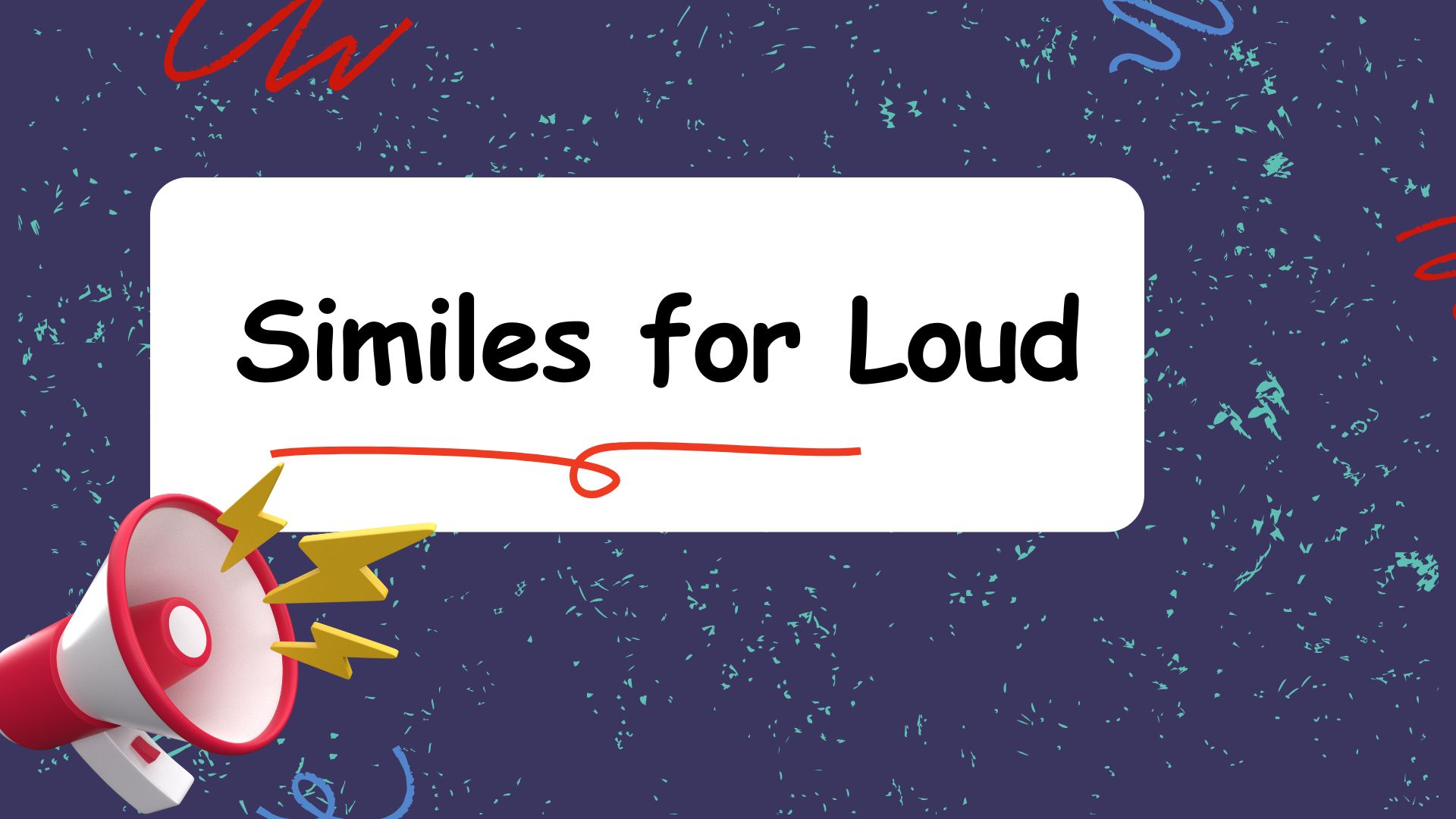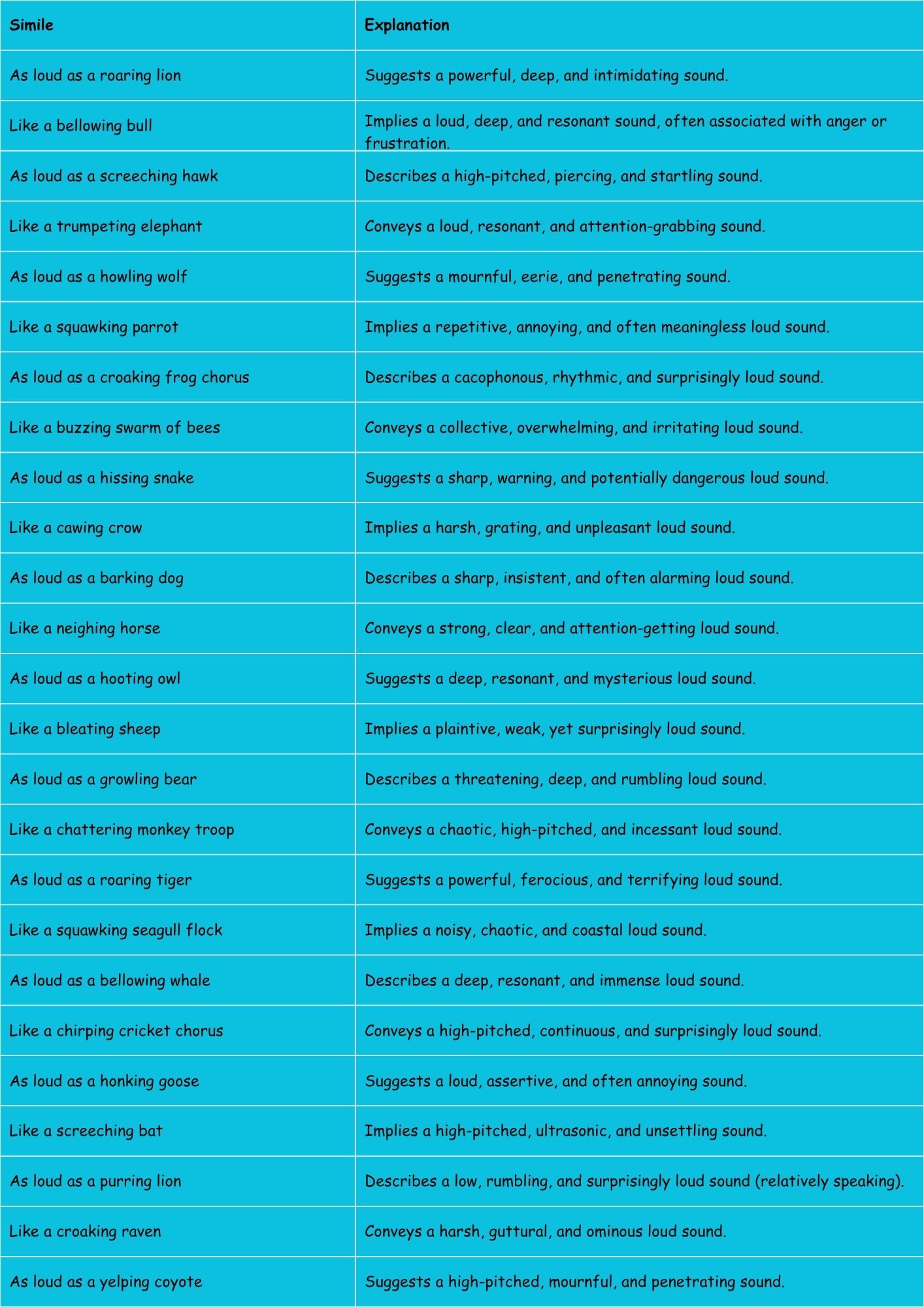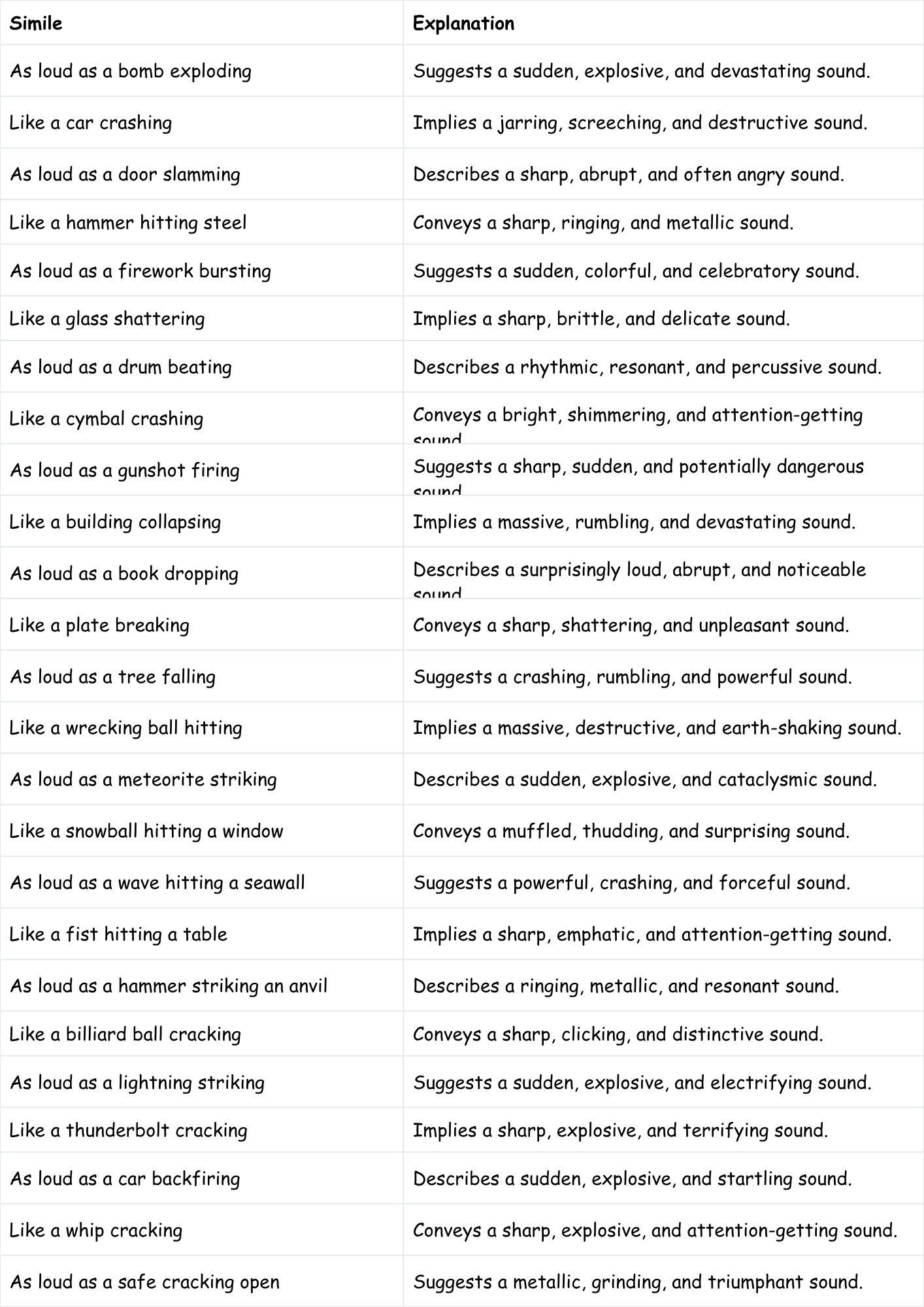
Similes for Loud: Amplifying Your English Vocabulary

Similes are powerful tools in the English language, allowing us to create vivid and memorable descriptions by comparing one thing to another. Understanding and using similes effectively can significantly enhance your writing and speaking skills. This article delves into the world of similes for the adjective “loud,” providing a comprehensive guide for English language learners of all levels. By exploring various similes, their meanings, and usage, you’ll gain a deeper appreciation for the nuances of the English language and learn how to express yourself with greater precision and flair. This resource is particularly beneficial for students, writers, and anyone looking to enrich their vocabulary and improve their communication skills.
This article will cover the definition of similes, the specific application of similes related to loudness, various examples categorized for clarity, rules for proper usage, common mistakes to avoid, practice exercises to reinforce learning, and frequently asked questions to address common concerns. Get ready to amplify your understanding of similes and your ability to describe sounds!
Table of Contents
- Introduction
- Definition of Similes
- Structural Breakdown of Similes
- Categories of Similes for Loud
- Examples of Similes for Loud
- Usage Rules for Similes
- Common Mistakes with Similes
- Practice Exercises
- Advanced Topics: Nuances and Connotations
- Frequently Asked Questions
- Conclusion
Definition of Similes
A simile is a figure of speech that compares two unlike things using the words “like” or “as.” The purpose of a simile is to create a vivid image or enhance the understanding of a concept by drawing a parallel between something familiar and something less so. Similes add color and depth to language, making descriptions more engaging and memorable. They are a fundamental element of figurative language and are widely used in both written and spoken English.
In essence, a simile asserts a resemblance between two things that are not inherently similar. This comparison helps to illuminate a particular quality or characteristic of the subject being described. For instance, saying “He is as brave as a lion” doesn’t mean the person is a lion, but rather that they possess the characteristic of bravery associated with lions. The effectiveness of a simile lies in its ability to create a strong mental image and evoke emotions in the reader or listener.
Structural Breakdown of Similes
Similes typically follow a simple structure:
[Subject] + [linking word (like/as)] + [object of comparison]
Let’s break down each component:
- Subject: The thing being described. This is the noun or noun phrase that we want to characterize.
- Linking Word: This is either “like” or “as.” These words explicitly signal that a comparison is being made.
- Object of Comparison: The thing that the subject is being compared to. This object should possess a quality that is also present in the subject, allowing for a meaningful comparison.
For example, in the simile “The thunder was like a roaring lion,” “thunder” is the subject, “like” is the linking word, and “a roaring lion” is the object of comparison. The simile suggests that the thunder possesses a quality similar to the roar of a lion – its loudness and intensity.
The order of the elements can sometimes be varied for stylistic effect, but the core components of subject, linking word, and object of comparison remain essential. Understanding this basic structure makes it easier to both identify and create effective similes.
Categories of Similes for Loud
Similes for “loud” can be categorized based on the type of sound being compared. This categorization helps to provide a more nuanced understanding of the different ways loudness can be expressed.
Animal Sounds
This category compares loudness to the sounds made by various animals, often emphasizing their power and intensity.
Nature Sounds
This category uses natural phenomena such as thunder, storms, and waterfalls to convey the magnitude of the sound.
Machine Sounds
This category relies on the sounds of machines and technology to depict loudness, often suggesting a mechanical or industrial quality.
Human Sounds
This category focuses on sounds produced by humans, such as shouting, screaming, or singing, to illustrate the intensity of loudness.
Impact Sounds
This category employs sounds created by impacts or collisions to convey the suddenness and forcefulness of the sound.
Examples of Similes for Loud
Here are several examples of similes for “loud,” categorized for clarity and understanding. Each category provides a unique perspective on how loudness can be described using figurative language.
Animal Sounds
This table presents examples of similes that compare loudness to the sounds made by animals. These similes often evoke images of powerful and intense sounds. The descriptive paragraphs before and after each table provide additional context and explanation.
The following table demonstrates how various animal sounds can be used to describe different types of loudness. Consider the specific connotations each animal brings to the comparison.
| Simile | Explanation |
|---|---|
| As loud as a roaring lion | Suggests a powerful, deep, and intimidating sound. |
| Like a bellowing bull | Implies a loud, deep, and resonant sound, often associated with anger or frustration. |
| As loud as a screeching hawk | Describes a high-pitched, piercing, and startling sound. |
| Like a trumpeting elephant | Conveys a loud, resonant, and attention-grabbing sound. |
| As loud as a howling wolf | Suggests a mournful, eerie, and penetrating sound. |
| Like a squawking parrot | Implies a repetitive, annoying, and often meaningless loud sound. |
| As loud as a croaking frog chorus | Describes a cacophonous, rhythmic, and surprisingly loud sound. |
| Like a buzzing swarm of bees | Conveys a collective, overwhelming, and irritating loud sound. |
| As loud as a hissing snake | Suggests a sharp, warning, and potentially dangerous loud sound. |
| Like a cawing crow | Implies a harsh, grating, and unpleasant loud sound. |
| As loud as a barking dog | Describes a sharp, insistent, and often alarming loud sound. |
| Like a neighing horse | Conveys a strong, clear, and attention-getting loud sound. |
| As loud as a hooting owl | Suggests a deep, resonant, and mysterious loud sound. |
| Like a bleating sheep | Implies a plaintive, weak, yet surprisingly loud sound. |
| As loud as a growling bear | Describes a threatening, deep, and rumbling loud sound. |
| Like a chattering monkey troop | Conveys a chaotic, high-pitched, and incessant loud sound. |
| As loud as a roaring tiger | Suggests a powerful, ferocious, and terrifying loud sound. |
| Like a squawking seagull flock | Implies a noisy, chaotic, and coastal loud sound. |
| As loud as a bellowing whale | Describes a deep, resonant, and immense loud sound. |
| Like a chirping cricket chorus | Conveys a high-pitched, continuous, and surprisingly loud sound. |
| As loud as a honking goose | Suggests a loud, assertive, and often annoying sound. |
| Like a screeching bat | Implies a high-pitched, ultrasonic, and unsettling sound. |
| As loud as a purring lion | Describes a low, rumbling, and surprisingly loud sound (relatively speaking). |
| Like a croaking raven | Conveys a harsh, guttural, and ominous loud sound. |
| As loud as a yelping coyote | Suggests a high-pitched, mournful, and penetrating sound. |
As you can see, comparing a sound to different animal noises can evoke very different images and feelings. The choice of animal depends on the specific nuance you want to convey regarding the loudness.

Nature Sounds
This table presents similes that compare loudness to natural phenomena. These similes often evoke images of powerful and overwhelming sounds. The descriptive paragraphs before and after each table provide additional context and explanation.
Nature provides many examples of powerful sounds. These similes use these natural occurrences to illustrate extreme loudness.
| Simile | Explanation |
|---|---|
| As loud as a thunderclap | Suggests a sudden, explosive, and deafening sound. |
| Like a crashing waterfall | Implies a continuous, powerful, and overwhelming sound. |
| As loud as a raging storm | Describes a tumultuous, chaotic, and all-encompassing sound. |
| Like a volcanic eruption | Conveys a powerful, sudden, and destructive sound. |
| As loud as an avalanche | Suggests a massive, rumbling, and unstoppable sound. |
| Like a hurricane’s roar | Implies a sustained, powerful, and destructive wind and sound. |
| As loud as the ocean’s roar | Describes a deep, constant, and overwhelming sound. |
| Like a forest fire crackling | Conveys a sharp, intense, and rapidly spreading sound. |
| As loud as a geyser erupting | Suggests a sudden, forceful, and explosive sound. |
| Like wind howling through a canyon | Implies a mournful, echoing, and powerful sound. |
| As loud as a landslide rumbling | Describes a deep, continuous, and destructive sound. |
| Like a glacier calving | Conveys a massive, cracking, and thunderous sound. |
| As loud as a desert sandstorm | Suggests a gritty, howling, and overwhelming sound. |
| Like a rushing river after rain | Implies a powerful, surging, and relentless sound. |
| As loud as the Northern Lights crackling | Describes a faint, ethereal, yet audible sound. |
| Like a wave crashing on rocks | Conveys a sharp, explosive, and forceful sound. |
| As loud as a tornado’s funnel | Suggests a terrifying, swirling, and destructive sound. |
| Like ice cracking on a frozen lake | Implies a sharp, brittle, and ominous sound. |
| As loud as a volcano rumbling | Describes a deep, subterranean, and threatening sound. |
| Like a blizzard’s whiteout | Conveys a silent visual, but implies the howling wind and associated sound. |
| As loud as a seismic shift | Describes a deep, rumbling, and earth-shattering sound. |
| Like a tidal wave surging | Implies a powerful, overwhelming, and destructive sound. |
| As loud as a rockslide cascading | Suggests a chaotic, rumbling, and unstoppable sound. |
| Like a waterfall plummeting | Conveys a constant, powerful, and overwhelming sound. |
| As loud as a dust devil whirling | Describes a gritty, swirling, and surprisingly loud sound. |
Using nature as a point of comparison can help to convey the raw power and intensity of extreme loudness. These similes are particularly effective in descriptive writing where creating a strong sense of place and atmosphere is important.
Machine Sounds
This table provides similes that compare loudness to the sounds of machines. These similes often evoke images of mechanical, industrial, or technological sounds. The descriptive paragraphs before and after each table provide additional context and explanation.
Machines often produce loud and distinctive sounds. These similes leverage those sounds to describe other instances of loudness.
| Simile | Explanation |
|---|---|
| As loud as a jet engine | Suggests a powerful, high-pitched, and deafening sound. |
| Like a jackhammer pounding | Implies a repetitive, jarring, and intensely loud sound. |
| As loud as a construction site | Describes a cacophonous, chaotic, and overwhelming sound. |
| Like a factory floor | Conveys a constant, noisy, and industrial sound. |
| As loud as a motorcycle revving | Suggests a powerful, throaty, and attention-grabbing sound. |
| Like a train roaring past | Implies a massive, rumbling, and earth-shaking sound. |
| As loud as a siren wailing | Describes a piercing, urgent, and alarming sound. |
| Like a garbage truck compacting | Conveys a crushing, grinding, and unpleasant sound. |
| As loud as a lawnmower buzzing | Suggests a repetitive, annoying, and persistent sound. |
| Like a helicopter taking off | Implies a powerful, whirring, and shaking sound. |
| As loud as a pneumatic drill | Describes a sharp, hammering, and intensely loud sound. |
| Like a printing press running | Conveys a rhythmic, clattering, and continuous sound. |
| As loud as a power saw cutting | Suggests a high-pitched, grating, and potentially dangerous sound. |
| Like a blender pulverizing | Implies a whirring, grinding, and messy sound. |
| As loud as a vacuum cleaner roaring | Describes a consistent, droning, and annoying sound. |
| Like a car alarm blaring | Conveys a piercing, repetitive, and irritating sound. |
| As loud as a stadium crowd cheering | Suggests a collective, overwhelming, and enthusiastic sound. |
| Like a rock concert amplified | Implies an extremely loud, distorted, and intense sound. |
| As loud as a rocket launching | Describes a powerful, explosive, and awe-inspiring sound. |
| Like a subway train screeching | Conveys a high-pitched, grating, and unpleasant sound. |
| As loud as a conveyor belt clanking | Suggests a repetitive, industrial, and monotonous sound. |
| Like a generator humming | Implies a constant, low-frequency, and background sound. |
| As loud as a jet taking off | Describes a powerful, roaring, and accelerating sound. |
| Like a printing press thundering | Conveys a deep, booming, and industrial sound. |
| As loud as a robot malfunctioning | Suggests a chaotic, erratic, and alarming sound. |
Machine sounds are often associated with modern life and technology. Using these similes can help to create a sense of modernity or to emphasize the artificial or mechanical nature of a loud sound.
Human Sounds
This table illustrates similes that compare loudness to sounds made by humans. These similes often evoke images of emotional or expressive sounds. The descriptive paragraphs before and after each table provide additional context and explanation.
Human vocalizations can range from whispers to shouts. These similes use the louder end of that spectrum to describe other loud sounds.
| Simile | Explanation |
|---|---|
| As loud as a screaming crowd | Suggests a collective, high-pitched, and overwhelming sound. |
| Like a shout in a canyon | Implies an echoing, amplified, and resonant sound. |
| As loud as a singer belting | Describes a powerful, sustained, and clear sound. |
| Like a drill sergeant yelling | Conveys a commanding, sharp, and intimidating sound. |
| As loud as a child screaming | Suggests a high-pitched, piercing, and attention-grabbing sound. |
| Like a stadium chanting | Implies a rhythmic, collective, and enthusiastic sound. |
| As loud as someone bellowing | Describes a deep, resonant, and forceful sound. |
| Like a town crier proclaiming | Conveys a clear, loud, and attention-getting sound. |
| As loud as a foghorn blowing | Suggests a deep, resonant, and warning sound. (Technically a machine, but mimics a human blowing.) |
| Like a protester shouting | Implies a passionate, forceful, and attention-grabbing sound. |
| As loud as a lecturer projecting | Describes a clear, strong, and audible sound. |
| Like an auctioneer calling | Conveys a rapid, rhythmic, and distinctive sound. |
| As loud as a sports announcer booming | Suggests a deep, resonant, and authoritative sound. |
| Like a referee whistling | Implies a sharp, piercing, and attention-getting sound. |
| As loud as a tour guide narrating | Describes a clear, audible, and engaging sound. |
| Like a street performer singing | Conveys a passionate, expressive, and attention-getting sound. |
| As loud as a parent scolding | Suggests a stern, forceful, and authoritative sound. |
| Like a comedian delivering a punchline | Implies a surprising, impactful, and laughter-inducing sound. |
| As loud as a gospel choir singing | Describes a powerful, harmonious, and uplifting sound. |
| Like a town meeting debating | Conveys a chaotic, argumentative, and overlapping sound. |
| As loud as a political rally protesting | Suggests a passionate, collective, and forceful sound. |
| Like a public address system announcing | Implies a clear, amplified, and informative sound. |
| As loud as a cheerleader rallying | Describes an enthusiastic, energetic, and coordinated sound. |
| Like a fire alarm sounding | Conveys a piercing, urgent, and alarming sound. |
| As loud as a baby wailing | Suggests a high-pitched, insistent, and distressing sound. |
Similes based on human sounds can be particularly effective in conveying emotions and creating a sense of immediacy. They can help to connect with the reader or listener on a more personal level.
Impact Sounds
This table offers similes that compare loudness to sounds created by impacts. These similes often evoke images of sudden, forceful, and often destructive sounds. The descriptive paragraphs before and after each table provide additional context and explanation.
The suddenness and force of impacts often create loud sounds. These similes utilize those sounds to describe other instances of loudness.
| Simile | Explanation |
|---|---|
| As loud as a bomb exploding | Suggests a sudden, explosive, and devastating sound. |
| Like a car crashing | Implies a jarring, screeching, and destructive sound. |
| As loud as a door slamming | Describes a sharp, abrupt, and often angry sound. |
| Like a hammer hitting steel | Conveys a sharp, ringing, and metallic sound. |
| As loud as a firework bursting | Suggests a sudden, colorful, and celebratory sound. |
| Like a glass shattering | Implies a sharp, brittle, and delicate sound. |
| As loud as a drum beating | Describes a rhythmic, resonant, and percussive sound. |
| Like a cymbal crashing | Conveys a bright, shimmering, and attention-getting sound. |
| As loud as a gunshot firing | Suggests a sharp, sudden, and potentially dangerous sound. |
| Like a building collapsing | Implies a massive, rumbling, and devastating sound. |
| As loud as a book dropping | Describes a surprisingly loud, abrupt, and noticeable sound. |
| Like a plate breaking | Conveys a sharp, shattering, and unpleasant sound. |
| As loud as a tree falling | Suggests a crashing, rumbling, and powerful sound. |
| Like a wrecking ball hitting | Implies a massive, destructive, and earth-shaking sound. |
| As loud as a meteorite striking | Describes a sudden, explosive, and cataclysmic sound. |
| Like a snowball hitting a window | Conveys a muffled, thudding, and surprising sound. |
| As loud as a wave hitting a seawall | Suggests a powerful, crashing, and forceful sound. |
| Like a fist hitting a table | Implies a sharp, emphatic, and attention-getting sound. |
| As loud as a hammer striking an anvil | Describes a ringing, metallic, and resonant sound. |
| Like a billiard ball cracking | Conveys a sharp, clicking, and distinctive sound. |
| As loud as a lightning striking | Suggests a sudden, explosive, and electrifying sound. |
| Like a thunderbolt cracking | Implies a sharp, explosive, and terrifying sound. |
| As loud as a car backfiring | Describes a sudden, explosive, and startling sound. |
| Like a whip cracking | Conveys a sharp, explosive, and attention-getting sound. |
| As loud as a safe cracking open | Suggests a metallic, grinding, and triumphant sound. |
Impact sounds are often associated with suddenness and force. Using these similes can help to emphasize the immediate and powerful nature of a loud sound.

Usage Rules for Similes
Using similes effectively requires understanding a few key rules:
- Clarity: The comparison should be clear and easy to understand. The object of comparison should be familiar enough that the audience can readily grasp the intended meaning.
- Relevance: The object of comparison should share a relevant quality with the subject being described. The similarity should be meaningful and contribute to a better understanding of the subject.
- Originality: While common similes can be effective, striving for originality can make your writing more engaging and memorable. Try to find fresh and unexpected comparisons.
- Context: The simile should be appropriate for the context in which it is used. Consider the tone, audience, and purpose of the writing or speech.
- Avoid Clichés: Overused similes, such as “as loud as thunder,” can sound stale and uninspired. Try to find more creative and original comparisons.
By following these rules, you can use similes to enhance your writing and speaking, making your descriptions more vivid, engaging, and memorable.
Common Mistakes with Similes
Here are some common mistakes to avoid when using similes:
- Using Metaphors Instead of Similes: A metaphor states that something is something else, while a simile uses “like” or “as” to make a comparison.
Incorrect (Metaphor): The music was a roaring lion.
Correct (Simile): The music was like a roaring lion.
- Using Unclear Comparisons: The object of comparison should be familiar and easily understood.
Incorrect: The sound was as loud as a flurgon’s cry. (What’s a flurgon?)
Correct: The sound was as loud as a hawk’s cry.
- Using Illogical Comparisons: The comparison should be meaningful and relevant.
Incorrect: The sound was as loud as a quiet mouse. (This is contradictory.)
Correct: The sound was as loud as a roaring lion.
- Overusing Similes: Using too many similes in a short space can make your writing feel cluttered and distracting.
Being aware of these common mistakes can help you use similes more effectively and avoid weakening your writing.
Practice Exercises
Test your understanding of similes for “loud” with these exercises. Choose the best simile to complete each sentence.
Exercise 1:
| Question | Answer |
|---|---|
| 1. The concert was __________. (a. as quiet as a library, b. as loud as a jet engine, c. as soft as a whisper) | b. as loud as a jet engine |
| 2. The thunder was __________ during the storm. (a. like a gentle breeze, b. like a crashing waterfall, c. like a silent movie) | b. like a crashing waterfall |
| 3. The construction site was __________ in the morning. (a. as quiet as a mouse, b. as loud as a construction site, c. as peaceful as a garden) | b. as loud as a construction site |
| 4. The baby’s cry was __________ in the middle of the night. (a. like a soothing lullaby, b. like a gentle hum, c. like a siren wailing) | c. like a siren wailing |
| 5. The explosion was __________ and shook the ground. (a. as loud as a pin dropping, b. as loud as a bomb exploding, c. as quiet as a feather falling) | b. as loud as a bomb exploding |
| 6. The music from the party next door was __________. (a. as faint as a whisper, b. as loud as a rock concert, c. as calming as nature sounds) | b. as loud as a rock concert |
| 7. The speaker’s voice was __________, filling the entire auditorium. (a. as soft as silk, b. as loud as a shout in a canyon, c. as muted as a violin) | b. as loud as a shout in a canyon |
| 8. The motorcycle’s engine was __________, disturbing the peace of the neighborhood. (a. like a purring kitten, b. like a motorcycle revving, c. like a bicycle bell) | b. like a motorcycle revving |
| 9. The alarm clock was __________, jolting me awake. (a. as gentle as a caress, b. as loud as a fire alarm, c. as quiet as a shadow) | b. as loud as a fire alarm |
| 10. The crowd’s cheer was __________, echoing through the stadium. (a. like a polite applause, b. like a stadium chanting, c. like a silent agreement) | b. like a stadium chanting |
Exercise 2:
Create your own similes for “loud” based on the following prompts:
| Prompt | Possible Answer |
|---|---|
| 1. Describe the sound of a busy city street. | As loud as a beehive of activity. |
| 2. Describe the sound of a heavy metal concert. | Like a wall of amplified sound crashing down. |
| 3. Describe the sound of a crying baby on an airplane. | As loud as a jet engine to a sensitive ear. |
| 4. Describe the sound of fireworks on the Fourth of July. | Like a series of explosions lighting up the sky. |
| 5. Describe the sound of a train passing by. | As loud as a metal monster rumbling past. |
| 6. Describe the sound of a crowded market. | Like a cacophony of voices and bartering. |
| 7. Describe the sound of a basketball game. | As loud as a roaring crowd and squeaking shoes. |
| 8. Describe the sound of a thunderstorm. | Like the sky splitting open with a deafening roar. |
| 9. Describe the sound of a factory. | As loud as an army of machines working together. |
| 10. Describe the sound of a party. | Like a symphony of laughter, music, and chatter. |
Advanced Topics: Nuances and Connotations
Beyond the basic structure and usage of similes, there are more advanced considerations that can further enhance your writing. Understanding the nuances and connotations of different words and comparisons can add depth and subtlety to your descriptions.
- Connotation: Consider the emotional associations of the words you choose. For example, “as loud as a scream” has a different connotation than “as loud as a shout.” The former suggests fear or distress, while the latter suggests anger or excitement.
- Sensory Detail: Engage multiple senses in your similes. For example, instead of just saying “as loud as a jet engine,” you could say “as loud as a jet engine, vibrating the ground beneath your feet.”
- Cultural Context: Be aware that the meaning and impact of a simile can vary depending on cultural context. A simile that is effective in one culture may not be as effective in another.
By paying attention to these advanced topics, you can use similes to create richer, more nuanced, and more impactful descriptions.
Frequently Asked Questions
- What is the difference between a simile and a metaphor?A simile compares two things using “like” or “as,” while a metaphor states that one thing is another. For example, “He is like a lion” (simile) versus “He is a lion” (metaphor).
- Why are similes important in writing?Similes add vividness, clarity, and emotional impact to writing. They help readers visualize and understand concepts by drawing comparisons to familiar things.
-
How can I avoid using clichés in my similes?
To avoid clichés, try to think outside the box and come up with original comparisons. Consider the specific qualities of the subject you are describing and look for less obvious objects of comparison. Brainstorming and experimenting with different ideas can help you create fresh and engaging similes.
-
Are there any situations where I should avoid using similes?
While similes can be powerful, they are not always appropriate. In highly technical or scientific writing, where precision and objectivity are paramount, similes may be seen as too subjective or imprecise. Additionally, overusing similes can make your writing feel cluttered and distracting.
-
How do I choose the best simile for a particular situation?
Consider the specific qualities you want to emphasize, the tone of your writing, and your target audience. The best simile will be clear, relevant, original, and appropriate for the context. Experiment with different options and choose the one that creates the strongest and most effective image.
Conclusion
Similes are invaluable tools for enriching your descriptions and conveying the intensity of loudness in various contexts. By understanding the structure, categories, and usage rules of similes, you can effectively enhance your writing and speaking skills. Through the examples provided and the practice exercises, you’ve gained practical experience in crafting and identifying compelling similes for “loud.” Remember to avoid common mistakes and strive for originality to make your descriptions truly stand out. As you continue to explore the English language, embrace the power of similes to add color, depth, and impact to your communication.



